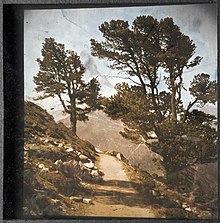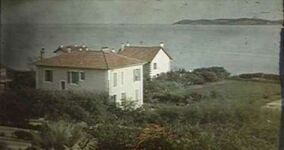Lippmann plate

Lippmann process photography is an early color photography method and type of alternative process photography. It was invented by French scientist Gabriel Lippmann in 1891 and consists of first encoding an image into a plate (by introducing an interference effect to standing waves with a mercury mirror) and then reconstructing the image (using diffraction) by illuminating the plate. The method is also known as interferential colour photography or interferometric colour photography and the results it produces are sometimes called direct photochromes, interference photochromes, or Lippmann photochromes.[1][2] In French, the method is known as photographie interférentielle and the resulting images were originally exhibited as des vues lippmaniennes. Lippmann won the Nobel Prize in Physics in 1908 "for his method of reproducing colours photographically based on the phenomenon of interference".[3]
Images made with this method are created on a Lippmann plate: a clear glass plate (having no anti-halation backing), coated with an almost transparent (very low silver halide content) emulsion of extremely fine grains, typically 0.01 to 0.04 micrometres in diameter.[4] Consequently, Lippmann plates have an extremely high resolving power[5] exceeding 400 lines/mm.
Method
[edit]In Lippmann's method, a glass plate is coated with an ultra fine grain[6] light-sensitive film using the Albumen Process containing potassium bromide, then dried, sensitized in the silver bath, washed, irrigated with cyanine solution, and dried again. The back of the film is then brought into optical contact with a reflective surface. This is done by mounting the plate in a specialized holder with pure mercury behind the film. When it is exposed in the camera through the glass side of the plate, the light rays which strike the transparent light-sensitive film are reflected back on themselves and, by interference, create standing waves.[1] The standing waves cause exposure of the emulsion in diffraction patterns. The developed and fixated diffraction patterns constitute a Bragg condition in which diffuse, white light is scattered in a specular fashion and undergoes constructive interference in accordance to Bragg's law.[7] The result is an image having very similar colours as the original using a black and white photographic process.
For this method Lippmann won the Nobel Prize in Physics in 1908.[8]
The colour image can only be viewed in the reflection of a diffuse light source from the plate, making the field of view limited, and therefore not easily copied with conventional techniques. The method was very insensitive with the emulsions of the time and it never came into general use. Another reason Lippmann's process of colour photography did not succeed can be found in the invention of the autochrome plates by the Lumière brothers.[1] A technique derived from the Lippmann technique has been proposed as a method of producing images which can easily be viewed, but not copied, for security purposes.[9]
Gallery
[edit]-
A still life by Lippmann
-
Venice by Lippmann
-
Saas-Fee by Lippmann
-
Sainte-Maxime by Lippmann
-
An 1899 photochrome of a stuffed parrot made by Richard Neuhauss
-
A 1906 photochrome by Auguste Ponsot, Lippmann's student and colleague
Other sources of Lippmann plates
[edit]- The Kodak Spectroscopic Plate Type 649-F is specified with a resolving power of 2000 lines/mm.[10]
- A diffusion method for making silver bromide based holographic recording material[11]
References
[edit]- ^ a b c Eder, J.M. (1945) [1932]. History of Photography, 4th. edition [Geschichte der Photographie]. New York: Dover Publications. pp. 668, 670, 671, 672. ISBN 0-486-23586-6.
- ^ US 6556992
- ^ "The Nobel Prize in Physics 1908". NobelPrize.org. Stockholm: Nobel Prize Outreach AB 2024. 2024. Retrieved 26 October 2024.
- ^ R.W.G. Hunt, The Reproduction of Colour, 6th ed, p6
- ^ "Emulsion Definition". www.tpub.com. Archived from the original on 24 July 2010. Retrieved 12 January 2022.
- ^ "Recent developments in Lippman photography", Jean-Marc Fournier, Benjamin R. Alexander, et al.;Proc. SPIE 3358, 95 (1998)
- ^ Bragg diffraction
- ^ "Lippmann's and Gabor's Revolutionary Approach to Imaging". nobelprize.org. Archived from the original on 2006-07-12.
- ^ Bjelkhagen, Hans. "Optically Variable Device for Security Documents". Archived from the original on 21 October 2021.
- ^ Kodak Plates and Films for Scientific Photography. Rochester: Eastman Kodak Company. 1973. p. 13d. ISBN 0-87985-083-3.
- ^ Blyth, Jeff; Roger B. Millington; Andrew G. Mayes; Christopher R. Lowe, "A diffusion method for making silver bromide based holographic recording material", Institute of Biotechnology, University of Cambridge, Tennis Court Road, Cambridge, archived from the original on January 28, 2010, retrieved July 25, 2010
External links
[edit]- Exhibition of Gabriel Lippmann photochromeswith associated press materials at the Photo Élysée museum with technical assistance from EPFL university
- Wiki about Lippmann Process by Holography Forum
- Forum about Lippmann Process by Holography Forum
- Université de Lille video of photochrome examples (in French)
- Université de Lille article depicting Lippmann plates (in French)





![An 1899 photochrome of a stuffed parrot made by Richard Neuhauss [de]](http://upload.wikimedia.org/wikipedia/commons/thumb/6/63/Parrot_photo_made_by_Gabriel_Lippmann_in_1891.jpg/360px-Parrot_photo_made_by_Gabriel_Lippmann_in_1891.jpg)
![A 1906 photochrome by Auguste Ponsot [fr], Lippmann's student and colleague](http://upload.wikimedia.org/wikipedia/commons/thumb/d/d5/Bouquet_de_Fleurs-laboratoire_de_physique_de_la_facult%C3%A9_des_sciences_de_Lille_par_Auguste_Ponsot_vers_1905.png/244px-Bouquet_de_Fleurs-laboratoire_de_physique_de_la_facult%C3%A9_des_sciences_de_Lille_par_Auguste_Ponsot_vers_1905.png)